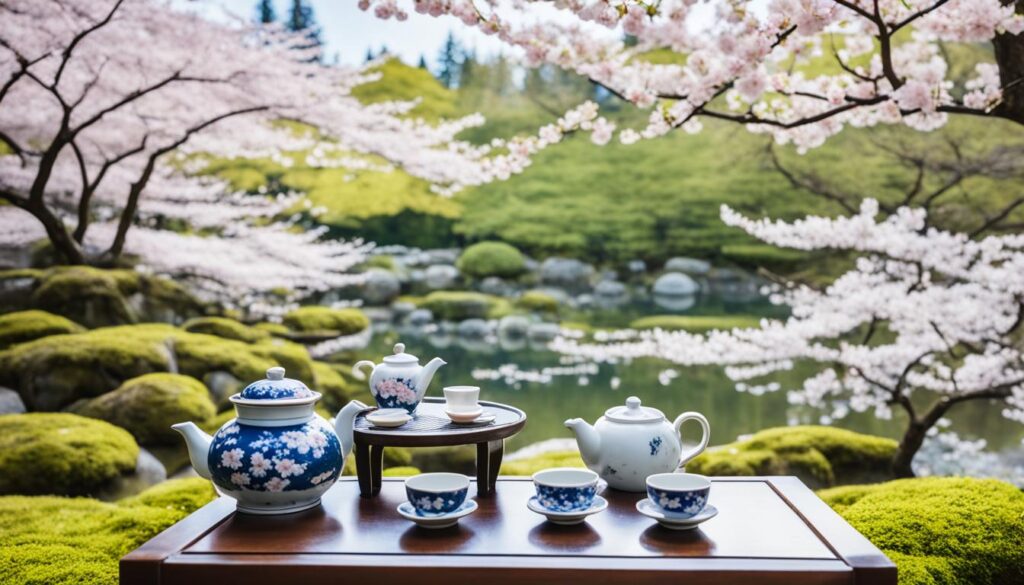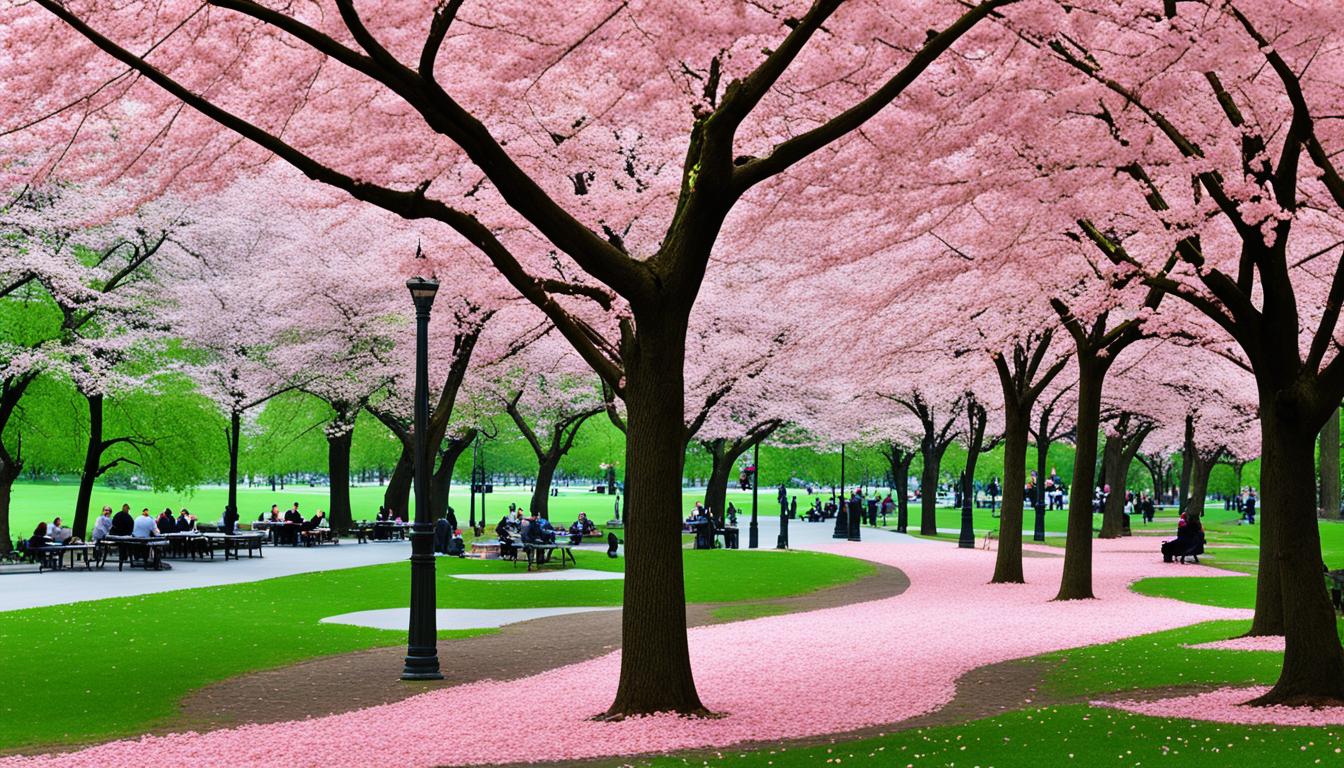In Japan, spring is a time of vibrant beauty and cultural celebration. With the arrival of cherry blossoms, known as sakura, and a variety of traditional festivities, spring in Japanese culture is a truly enchanting experience. From the different names for spring in Japanese to the seasonal activities and customs, this guide will take you through the wonders of spring in Japan.
The Arrival of Cherry Blossoms
Cherry blossoms are synonymous with spring in Japan and are a beloved symbol of the season. The bloom of cherry blossoms typically begins in late March and gradually spreads from the southern tip of Kyushu to the northern island of Hokkaido throughout April. Known as sakura in Japanese, the cherry blossoms create a stunning pink and white display across cities, towns, parks, and mountains, inviting locals and visitors alike to celebrate through the tradition of hanami, or flower-viewing.
Parks like Shinjuku Gyoen National Garden in Tokyo and Ueno Park are popular spots for hanami parties, where people gather under the cherry trees to enjoy food, drinks, and the beauty of the blossoms.
| Spot | Location | Best Time to Visit |
|---|---|---|
| Shinjuku Gyoen National Garden | Tokyo | Late March to early April |
| Ueno Park | Tokyo | Late March to early April |
Whether you’re strolling through a bustling city or exploring a peaceful park, the sight of cherry blossoms in full bloom is truly mesmerizing. It’s a magical experience that captures the essence of spring in Japan and leaves a lasting impression.
Traditional Spring Celebrations
In addition to cherry blossom viewing, spring in Japan is marked by a variety of traditional celebrations. One of the most notable is Hina Matsuri, also known as Girl’s Day, which takes place on March 3rd. Families display hina dolls and peach blossoms to wish for the health and happiness of their daughters. Another significant event is Golden Week, which spans from late April to early May and consists of several national holidays including Shōwa Day, Constitution Memorial Day, and Greenery Day. During Golden Week, many Japanese people travel and enjoy a well-deserved break from work and school.
These traditional spring celebrations offer a glimpse into the rich cultural heritage of Japan. Hina Matsuri showcases the love and wishes for the well-being of girls, while Golden Week provides an opportunity for relaxation and exploration. Whether you participate in the elaborate rituals of Hina Matsuri or join the festive atmosphere of Golden Week, these celebrations add a touch of tradition and joy to the enchanting spring season in Japan.
Enjoying Nature’s Beauty
Spring in Japan is not just about cherry blossoms. The country boasts a rich variety of flowers and natural beauty during this season. Some popular spring blooms include wisteria, which can be admired at Ashikaga Flower Park in Tochigi, and nemophila, also known as baby blue eyes, which create a stunning blue carpet at Hitachi Seaside Park.
For those who love outdoor activities, Japan’s alpine routes offer breathtaking views of snow-capped peaks, charming villages, and scenic lakes and rivers. The Tateyama Kurobe Alpine Route is a popular trekking trail that opens in mid-April.
Weather and Travel Tips
The weather in Japan during spring can vary depending on the region. In general, temperatures start to warm up in March, but there may still be occasional rain and chilly days. April is milder with no extremes of heat or cold, making it a great time to explore the country. However, it is important to note that spring is also the pollen season in Japan, particularly from cedar trees, and many people suffer from allergies during this time. It is advisable to carry tissues and allergy medication if needed. Additionally, spring in Japan is a popular travel season, especially during cherry blossom season, so it is recommended to plan and book accommodations in advance.
| Month | Temperature Range (°C) | Precipitation (mm) |
|---|---|---|
| March | 8-18 | 70-100 |
| April | 12-22 | 50-80 |
Cultural Significance of Spring
Spring in Japan holds immense cultural significance, symbolizing new beginnings and fresh starts in both nature and people’s lives. It is a season that brings hope and renewal after the cold winter months. Throughout Japan, various traditions and customs are observed to celebrate the arrival of spring and embrace the opportunities it brings.
One significant tradition is the entrance ceremonies held for students and new employees. These ceremonies mark the beginning of their educational or professional journey and are often accompanied by rituals and speeches to inspire and motivate them. It is a time of excitement and anticipation for the future.
Spring also invokes a sense of reflection and gratitude in Japanese culture. People express their wishes for a happy and prosperous future while acknowledging the beauty and abundance that spring brings. It is a time to appreciate the blossoming flowers, the warmth of the sun, and the opportunities for growth and change.
Japanese Spring Traditions:
1. Hanami: The tradition of hanami, or flower-viewing, is deeply rooted in Japanese culture during spring. Families and friends gather under blooming cherry trees to enjoy picnic lunches, sake, and the beauty of cherry blossoms. It is a time for relaxation, appreciation of nature, and the strengthening of bonds.
2. Matsuri: Spring is the season for various traditional festivals, known as matsuri, held throughout Japan. These festivals showcase the rich cultural heritage of the country and often feature parades, performances, and delicious food. One notable spring festival is the Hina Matsuri, also known as Girls’ Day, where families display intricately dressed dolls to pray for the health and happiness of their daughters.
New Beginnings in Japanese Culture:
In Japanese culture, spring is associated with new beginnings and the start of a new chapter. It is a time for setting goals, making plans, and embarking on fresh endeavors. Many people take this opportunity to declutter their homes, plant new gardens, and embrace positive changes in their personal and professional lives.

| Tradition | Description |
|---|---|
| Hanami | A tradition of flower-viewing under cherry blossoms, bringing people together to appreciate nature’s beauty. |
| Matsuri | Traditional festivals held throughout Japan, showcasing the country’s cultural heritage through performances, parades, and food. |
| Hina Matsuri | Also known as Girls’ Day, it is a festival where families display intricately dressed dolls to pray for the health and happiness of their daughters. |
Capturing the Magic of Spring
Spring in Japan is a photographer’s dream, offering countless opportunities to capture the enchantment of the season. The delicate beauty of cherry blossoms, with their soft pink petals, creates a stunning backdrop for unforgettable pictures. Whether you’re visiting popular cherry blossom spots like Shinjuku Gyoen National Garden or exploring hidden gems like the tranquil gardens and temples, be sure to have your camera ready to capture the fleeting magic of spring.
But it’s not just cherry blossoms that make spring photography in Japan special. The country’s landscapes come alive with vibrant colors as other blooms emerge. From the vibrant wisteria at Ashikaga Flower Park to the mesmerizing blue carpet of nemophila at Hitachi Seaside Park, there are endless opportunities to capture nature’s beauty in all its splendor.
For a unique experience, consider visiting one of Japan’s strawberry farms during spring. As you indulge in the joy of flower-picking, you’ll also have the chance to capture delightful moments on camera. Not only will you savor the freshest strawberries, but you’ll also enjoy a fun outdoor activity surrounded by the picturesque scenery of the farm.
So, dust off your camera and embark on a spring photography adventure in Japan. Whether you’re a professional photographer or simply passionate about capturing beautiful moments, the wonders of spring await, ready to be immortalized through your lens.

